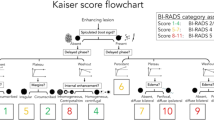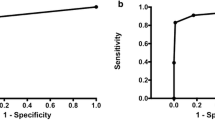Abstract
Objectives
To investigate the diagnostic performance of contrast-enhanced mammography (CEM) combined with the Kaiser score (KS) in digital breast tomosynthesis (DBT) BI-RADS 4A lesions to potentially reduce unnecessary breast biopsies.
Methods
This retrospective study evaluated 106 patients with 109 DBT BI-RADS 4A lesions from June 2019 to June 2021. For the absence of enhancement on CEM, the lesions were downgraded to BI-RADS 3. For lesions with enhancement, the readers were asked to classify all enhancing lesions referring to the KS for breast MRI. Receiver operating characteristic (ROC) curve analysis was used to evaluate the diagnostic performance. Two readers rated all cases and interreader agreement was assessed by Cohen’s kappa coefficients.
Results
There were ninety-five benign lesions and 14 malignant lesions. CEM combined with KS’s accuracy, represented by the area under the curve (AUC), ranged between 0.880 and 0.906. The use of the KS improved the performance, with a significant difference relative to a single BI-RADS reading or US (p < 0.001). CEM with KS had higher specificity than CEM with BI-RADS or US (p < 0.001), without difference in sensitivity (p > 0.05). CEM combined with KS could have potentially obviated 72 (75.8%) to 78 (82.1%) unnecessary benign biopsies in 95 benign lesions previously DBT classified as BI-RADS 4A. The interreader agreement was substantial (kappa: 0.727) for KS.
Conclusions
CEM combined with KS may be used in DBT BI-RADS 4A lesions to substantially reduce unnecessary benign biopsies.
Key Points
• CEM combined with the Kaiser scoring system shows high diagnostic performance for DBT BI-RADS 4A lesions.
• The application of CEM combined with the Kaiser scoring system may avoid 75.8% to 82.1% of unnecessary benign breast biopsies.
• CEM combined with the KS aids clinical decision-making in DBT BI-RADS 4A lesions.







Similar content being viewed by others
Abbreviations
- +LR:
-
Positive likelihood ratio
- AUC:
-
Area under the curve
- BI-RADS:
-
Breast Imaging-Reporting and Data System
- CC:
-
Craniocaudal
- CEM:
-
Contrast-enhanced mammography
- KS:
-
Kaiser score
- −LR:
-
Negative likelihood ratio
- ROC:
-
Receiver operator characteristic
- ROI:
-
Region of interest
- US:
-
Ultrasound
References
Sung H, Ferlay J, Siegel RL et al (2021) Global cancer statistics 2020: GLOBOCAN estimates of incidence and mortality worldwide for 36 cancers in 185 countries. CA Cancer J Clin 71:209–249
Tabár L, Yen AM, Wu WY et al (2015) Insights from the breast cancer screening trials: how screening affects the natural history of breast cancer and implications for evaluating service screening programs. Breast J 21:13–20
Chong A, Weinstein SP, McDonald ES, Conant EF (2019) Digital breast tomosynthesis: concepts and clinical practice. Radiology 292:1–14
D’Orsi CJ, Sickles EA, Mendelson EB et al (2013) ACR BI-RADS® atlas, breast imaging reporting and data system. Reston, American College of Radiology
Mann RM, Kuhl CK, Kinkel K, Boetes C (2008) Breast MRI: guidelines from the European Society of Breast Imaging. Eur Radiol 18:1307–1318
Ghaderi KF, Phillips J, Perry H, Lotfi P, Mehta TS (2019) Contrast-enhanced mammography: current applications and future directions. Radiographics 39:1907–1920
Fallenberg EM, Schmitzberger FF, Amer H et al (2017) Contrast-enhanced spectral mammography vs. mammography and MRI-clinical performance in a multi-reader evaluation. Eur Radiol 27:2752–2764
Kim EY, Youn I, Lee KH et al (2018) Diagnostic value of contrast-enhanced digital mammography versus contrast-enhanced magnetic resonance imaging for the preoperative evaluation of breast cancer. J Breast Cancer 21:453–462
Clauser P, Baltzer PAT, Kapetas P et al (2020) Low-dose contrast-enhanced mammography compared to contrast-enhanced breast MRI: a feasibility study. J Magn Reson Imaging 52:589–595
Knogler T, Homolka P, Hoernig M et al (2017) Application of BI- RADS descriptors in contrast enhanced dual-energy mammography: comparison with MRI. Breast Care (Basel) 12:212–216
Travieso-Aja MM, Maldonado-Saluzzi D, Naranjo-Santana P et al (2019) Evaluation of the applicability of BI-RADS® MRI for the interpretation of contrast-enhanced digital mammography. Radiologia 61:477–488
Marino MA, Riedl CC, Bernathova M et al (2018) Imaging phenotypes in women at high risk for breast cancer on mammography, ultrasound, and magnetic resonance imaging using the fifth edition of the breast imaging reporting and data system. Eur J Radiol 106:150–159
Dietzel M, Baltzer PAT (2018) How to use the Kaiser score as a clinical decision rule for diagnosis in multiparametric breast MRI: a pictorial essay. Insights Imaging 9:325–335
Wengert GJ, Pipan F, Almohanna J et al (2020) Impact of the Kaiser score on clinical decision-making in BI-RADS 4 mammographic calcifications examined with breast MRI. Eur Radiol 30:1451–1459
Milos RI, Pipan F, Kalovidouri A et al (2020) The Kaiser score reliably excludes malignancy in benign contrast-enhancing lesions classified as BI-RADS 4 on breast MRI high-risk screening exams. Eur Radiol 30:6052–6061
Jochelson MS, Lobbes MBI (2021) Contrast-enhanced mammography: state of the art. Radiology 299:36–48
Polat DS, Evans WP, Dogan BE (2020) Contrast-enhanced digital mammography: technique, clinical applications, and pitfalls. AJR Am J Roentgenol 215:1267–1278
Rudnicki W, Heinze S, Niemiec J et al (2019) Correlation between quantitative assessment of contrast enhancement in contrast-enhanced spectral mammography (CESM) and histopathology- preliminary results. Eur Radiol 29:6220–6226
Landis JR, Koch GG (1977) The measurement of observer agreement for categorical data. Biometrics 33:159–174
Baltzer PA, Dietzel M, Kaiser WA (2013) A simple and robust classification tree for differentiation between benign and malignant lesions in MR-mammography. Eur Radiol 23:2051–2060
Marino MA, Clauser P, Woitek R et al (2016) A simple scoring system for breast MRI interpretation: does it compensate for reader experience? Eur Radiol 26:2529–2537
Woitek R, Spick C, Schernthaner M et al (2017) A simple classification system (the tree flowchart) for breast MRI can reduce the number of unnecessary biopsies in MRI-only lesions. Eur Radiol 27:3799–3809
Ainakulova AS, Zholdybay ZZ, Kaidarova DR et al (2021) Contrast-enhanced spectral mammography without and with a delayed image for diagnosing malignancy among mass lesions in dense breast. Contemp Oncol (Pozn) 25:17–22
Huang JS, Pan HB, Yang TL et al (2020) Kinetic patterns of benign and malignant breast lesions on contrast enhanced digital mammogram. PLoS One 15:e0239271
Zuley ML, Bandos AI, Abrams GS et al (2020) Contrast enhanced digital mammography (CEDM) helps to safely reduce benign breast biopsies for low to moderately suspicious soft tissue lesions. Acad Radiol 27:969–976
Long R, Cao K, Cao M et al (2021) Improving the diagnostic accuracy of breast BI-RADS 4 microcalcification-only lesions using contrast-enhanced mammography. Clin Breast Cancer 21:256–262
Istomin A, Masarwah A, Vanninen R, Okuma H, Sudah M (2021) Diagnostic performance of the Kaiser score for characterizing lesions on breast MRI with comparison to a multiparametric classification system. Eur J Radiol 138:109659
Acknowledgements
I would like to express my gratitude to all those who helped me during the writing of this thesis. My deepest gratitude goes first and foremost to Professor Gaofeng Shi and Zhigang Li, for their encouragement and guidance.
Funding
This study has received funding from the Hebei Science and Technology Foundation (20377783D).
Author information
Authors and Affiliations
Corresponding author
Ethics declarations
Guarantor
The scientific guarantor of this publication is Gaofeng Shi.
Conflict of interest
The authors of this manuscript declare no relationships with any companies, whose products or services may be related to the subject matter of the article.
Statistics and biometry
One of the authors has significant statistical expertise.
Informed consent
Written informed consent was waived by the Institutional Review Board.
Ethical approval
Institutional Review Board approval was obtained.
Methodology
• retrospective
• diagnostic or prognostic study
• performed at one institution
Additional information
Publisher’s note
Springer Nature remains neutral with regard to jurisdictional claims in published maps and institutional affiliations.
Rights and permissions
About this article
Cite this article
Rong, X., Kang, Y., Xue, J. et al. Value of contrast-enhanced mammography combined with the Kaiser score for clinical decision-making regarding tomosynthesis BI-RADS 4A lesions. Eur Radiol 32, 7439–7447 (2022). https://doi.org/10.1007/s00330-022-08810-7
Received:
Revised:
Accepted:
Published:
Issue Date:
DOI: https://doi.org/10.1007/s00330-022-08810-7




